Public Financial Management (PFM) is often seen as a cross-cutting governance reform. The notion is that PFM improvements can lead to service delivery, anti-corruption, public investment and equality improvements – in other words, good PFM supports the delivery of the Sustainable Development Goals (SDGs).
The general logic is that good budget allocation and management supports desired outcomes.
How Does Public Financial Management Achieve the Sustainable Development Goals?
Over the last ten years FreeBalance, which is a signatory to the United Nations Global Compact, has perfected its analytical framework and clearly mapped out the alignment between good public financial management and the SDGs. We believe that PFM is an element of good governance and that the use of Government Resource Planning (GRP) software, like the FreeBalance Accountability Suite™, in turn supports PFM automation and government digital transformation.
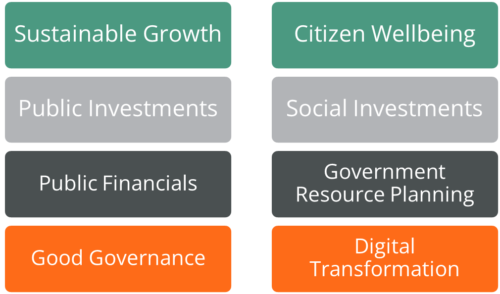
Good governance and government digital transformation enable sustainable development: sustainable growth and citizen wellbeing. We use an enablement and outcome structure that combines Worldwide Governance Indicators, Sustainable Development Goals, and the World Happiness Report when analyzing the impact of PFM reform. The framework is based on the notion that 17 SDGs include governance, growth and citizen wellbeing objectives. We put the social and equity SDGs into the wellbeing category to simplify analysis.
Citizen Wellbeing and the SDGs
Our approach helps to separate primarily citizen wellbeing (primarily social outcomes, like equity) from primarily growth outcomes (that also support social outcomes.) The reason for this distinction is to separate out primarily perception-based outcomes (such as fairness) with primarily quantitative outcomes (like GDP). As we have learned thanks to the Bhutan Gross Happiness Index, there are many social and cultural perception characteristics for evaluating government performance and effectiveness.

The first 15 SDGs relate directly to public infrastructure and social investments. We consider public investment management as a supporting PFM contribution. That’s because, as mentioned in the opening paragraph, good public finance practices enable public investment performance. This outcome can only be achieved when policy is aligned to budget planning and implementation.
Public Sector Budget Planning and the SDGs
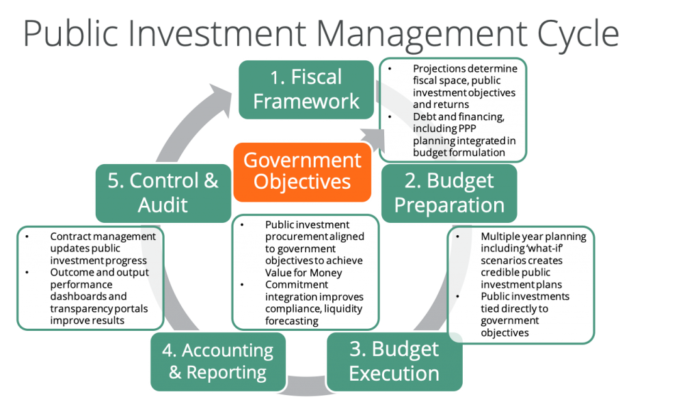
Effective PFM supports the public investment management budget cycle:
- Align government infrastructure and social investment objectives directly to budget preparation
- Analyze debt and financing requirements for credible budgets
- Plan contingencies based on risks and scenarios
- Integrate government objectives directly into Value for Money procurement methods
- Track output and outcome results through contract management integrated with SDG reporting
- Report procurement, output and outcome information transparently
How Can Governments Track SDG Spending and Results?
Automated tracking of spending and results relies on effective budget and accounting classifications. These classifications, that we call the Chart of Accounts (COA), are usually detailed and comprehensive in government. Public sector COA design is considerably more complex than what is used in businesses. SDG spending information can be inferred through the COA by what we call “side concepts” and “reporting objects”. This supports reporting on alternative ways of rolling up fiscal information. It does not require system users to know about these side concepts.
Governments typically use program segments to support SDG planning and spending. Governments also use side concepts to track spending against national development strategies that overlap on the SDGs. The use of a program segment helps to coordinate spending for specific objectives across government Ministries, Departments, and Agencies (MDAs).
Results-based budgeting, or government performance management, requires setting up output and outcome goals. These goals are tied to spending in a similar hierarchy as the COA. We call this functionality the Chart of Goals (COG). The COG is aligned directly to the COA to support cascading performance measures. The COA and the COG represents the core metadata for government fiscal and performance management. Metadata integration supports smart approaches to performance reporting in government, and open fiscal transparency.
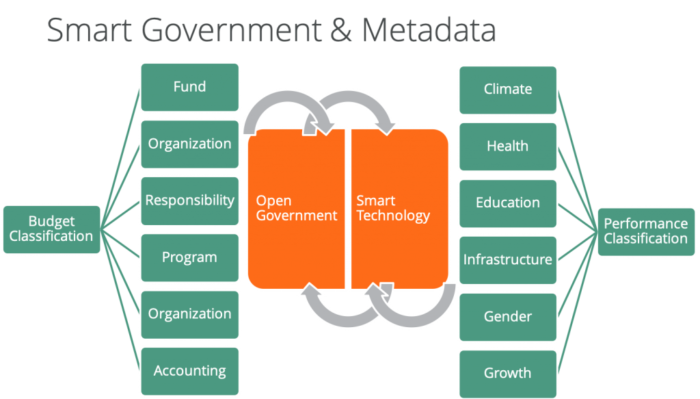
What About SDGs 16 and 17?
Good governance is an element of SDG 16 – “Peace, Justice, and Strong Institutions”. Social enterprises, like FreeBalance, support SDG 17, “Partnership for the Goals”. PFM can help governments and partners to achieve important SDG targets. Partners in this context can mean private companies, international donors, foundations, academic institutions, and civil society.
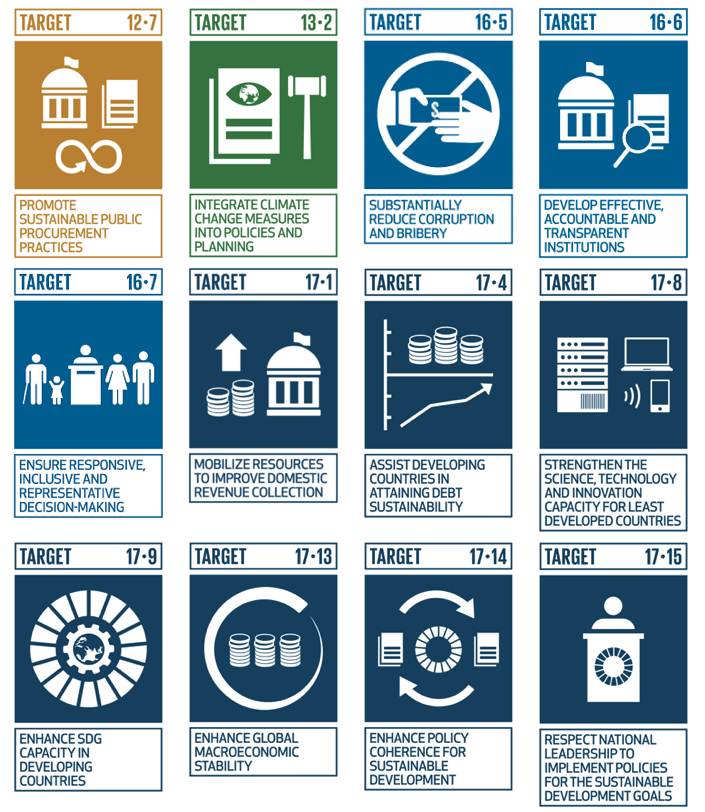
How Does Good PFM Support the SDGs?
- Promote Sustainable Public Procurement Practices (12.7) through using sustainability metrics in procurement value-for-money calculations (that can be tied to the national development strategy)
- Integrate Climate Change Measures into Policies and Planning (13.2) through program and performance budgeting throughout the public investment management lifecycle
- Substantially Reduce Corruption and Bribery (16.5) through integrated controls, fiscal transparency, and audit while paying public servants sufficiently and supporting career advancement (we consider civil service management as part of PFM)
- Develop Effective Accountable and Transparent Institutions (16.6) through fiscal transparency to provide legislators and civil society with “citizen audit” capabilities to support institution building an reform
- Ensure Responsive, Inclusive, and Representative Decision-Making (16.7) through open budgets, participatory budgeting and budget transparency portals
How Can Partnerships Support PFM Good Practices?
- Mobilize Resources to Improve Domestic Revenue Collection (17.1) through tax reform, integrated tax administration systems, reduced tax arrears
- Partners support increased tax compliance
- Assist Countries in Attaining Debt Sustainability (17.4) through effective multiple-year debt scenario planning and liquidity projections
- Partners provide financing instruments that can be realistically managed within government fiscal spaces and the use of innovative methods like green and blue bonds
- Strengthen the Science, Technology and Innovation Capacity for Least Developed Countries (17.8) through targeted planning and financing
- Partners provide innovation mentoring, centres of excellence, research endowments and joint ventures
- Enhance SDG Capacity in Developing Countries (17.9) by funding government capacity building, SDG citizen outreach and curriculums
- Partners provide good practice training materials and SDG mentoring
- Enhance Global Macroeconomic Stability (17.13) through credible fiscal frameworks, budgeting, and scenario planning for country resilience
- Partners work with governments to improve planning, and can coordinate actions through international organizations
- Enhance Policy Coherence for Sustainable Development (17.4) through integrated program and performance budgeting tied to national development strategies
- Partners provide policy feedback while extending government sustainability initiatives to communities
- Respect National Leadership to Implement Policies for the SDGs (17.5) by enhancing PFM so that country systems can be used and governments are able to use a pull model of country development
- Partners help to improve PFM country systems and agree to use country systems to enable cross-program SDG coordination while reducing transaction costs
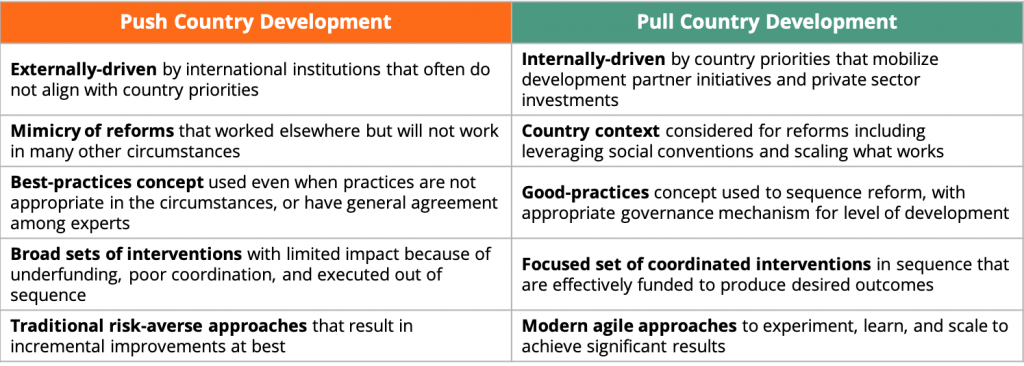
What are the Public Financial Management Implications of the SDGs?
The SDGs seem like yet another additional thing for governments to track. Yet, governments have been able to track Government Financial Statistics (GFS), the Classification of the Functions of Government (COFOG), and Millennium Development Goals (MDGs) in GRP systems without significant effort or requiring system users to understand the complexity of these structures because of the use of “side concepts”. Tracking spending against SDGs requires these side concepts, helped by program classifications.
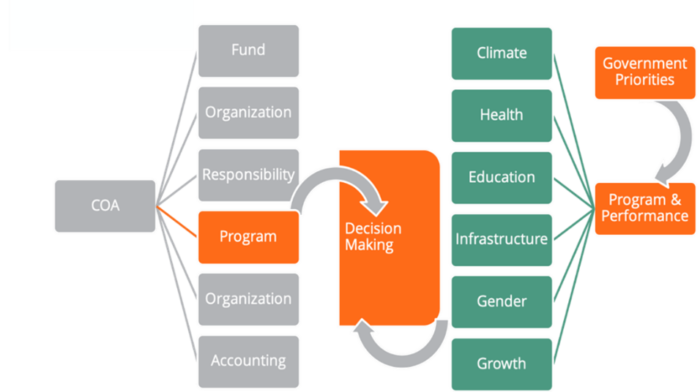
What’s different about the SDGs is the potential transformation of policy and budgeting. The SDG footprint is much broader and deeper than the MDGs. This provides governments with the opportunity to recast policy and priorities based on what’s important now, and in the future.
Concepts like wellbeing help governments to fund economic developments that are highly prized by citizens. This policy transformation has some interesting characteristics:
- Evidence-based rather than political dogma
- Outcome-based rather than input-based (similar to the above, moves the political debate away from spending to results)
- Innovation room can be provided in budgets to uncover inexpensive ways to over-perform (following a Public Finance Innovation Framework to be released next month)
- Exposes governance gaps that can be overcome to improve results at little or no additional costs
- Country prioritization based on the country context (including which SDGs are most important to drive budget allocation)
- Collective and holistic to motivate complementary actions and program coordination outside government
Addendum:
Good Governance
Worldwide Governance Indicators
- Voice and Accountability
- Political Stability and Absence of Violence
- Government Effectiveness
- Regulatory Quality
- Rule of Law
- Control of Corruption
- Goal 16: Peace, Justice and Strong Institutions
- Goal 17: Partnerships for the Goals
- Freedom of Life Choices
- Corruption Reduction
Citizen Wellbeing
- Healthy Life Expectancy
- Social Support
- Generosity
- Goal 3: Good Health and Well-being
- Goal 4: Quality Education
- Goal 5: Gender Equality
- Goal 10: Reduced Inequalities
Sustainable Development
- Income Improvement
- Goal 1: No Poverty
- Goal 2: Zero Hunger
- Goal 6: Clean Water & Sanitation
- Goal 7: Affordable and Clean Energy
- Goal 8: Decent Work & Economic Growth
- Goal 9: Industry, Innovation & Infrastructure
- Goal 11: Sustainable Cities & Communities
- Goal 12: Responsible Consumption & Production
- Goal 13: Climate Action
- Goal 14: Life Below Water
- Goal 15: Life on Land
